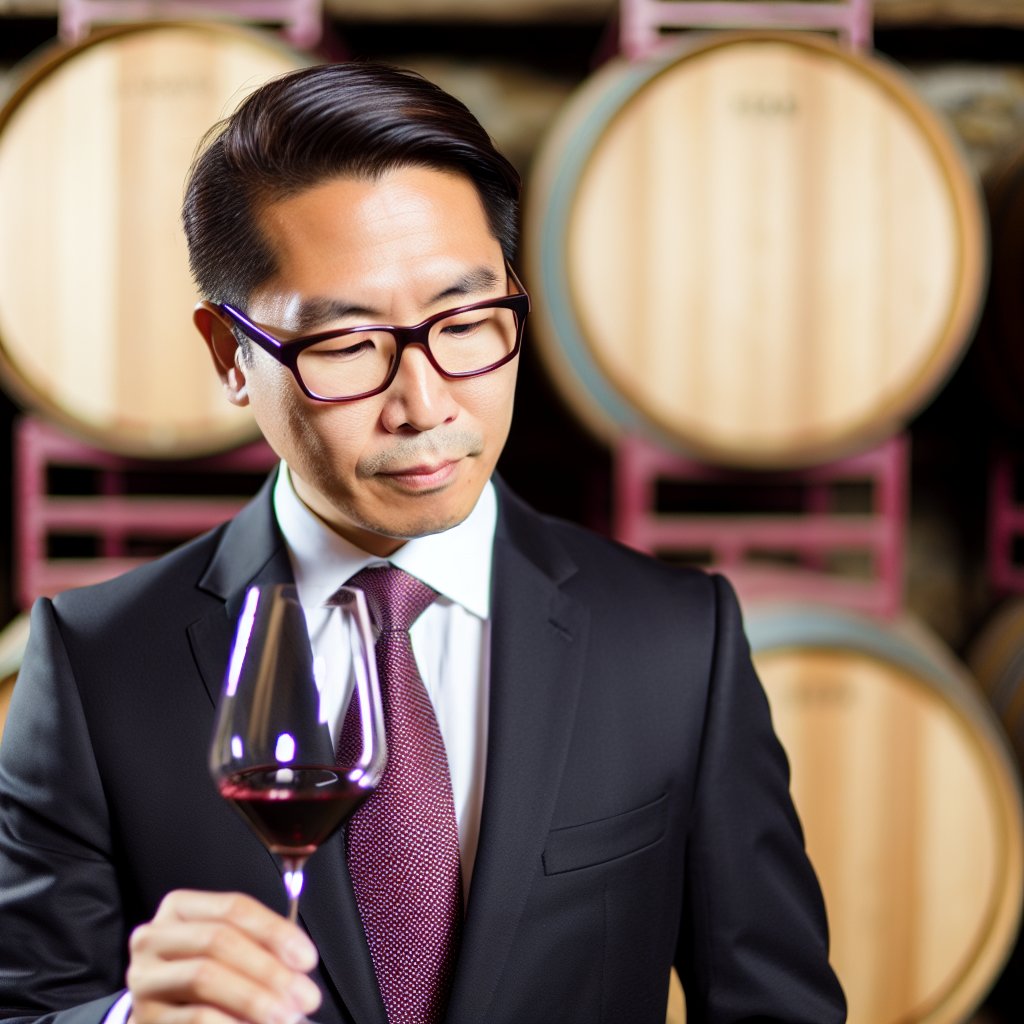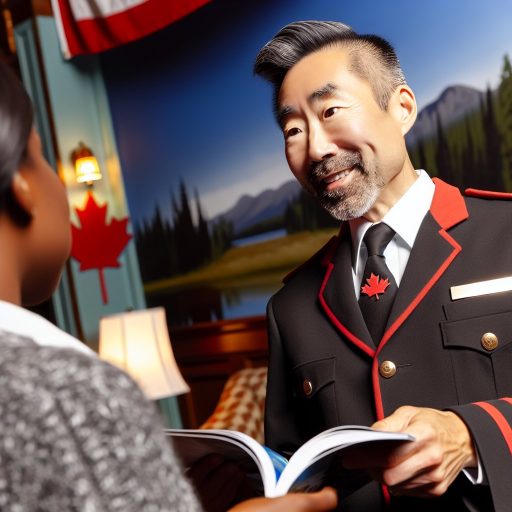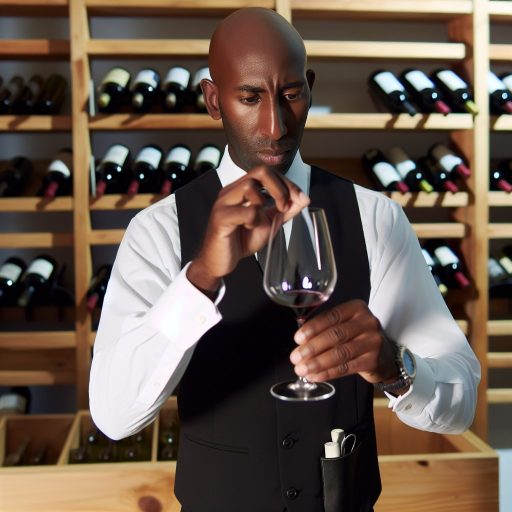Introduction to the Role of Sommeliers in Wine Analysis
Sommeliers play a crucial role in the wine industry.
They possess extensive knowledge of wine varieties and regions.
This expertise is essential for assisting customers with wine selections.
Additionally, sommeliers serve as educators in wine appreciation.
They understand the intricate flavors and aromas present in wine.
Moreover, they analyze wine to ascertain its quality and characteristics.
Wine tasting is a significant aspect of a sommelier’s duties.
To perform this task effectively, they train their palate continuously.
This training involves tasting various wines to identify subtle differences.
Furthermore, sommeliers study the impact of terroir on wine flavor.
They also familiarize themselves with food pairings to enhance dining experiences.
As they refine their sensory skills, their palate becomes a powerful tool.
Ultimately, their role enriches the overall wine experience for patrons.
Understanding the Sensory Components of Wine
Aroma
Aroma plays a crucial role in wine tasting.
Sommeliers identify various scents through practice.
They mainly focus on primary, secondary, and tertiary aromas.
Primary aromas come from the grapes themselves.
These include fruity, floral, and herbal notes.
Secondary aromas arise from fermentation processes.
These often exhibit yeasty or buttery characteristics.
Tertiary aromas develop during aging in the bottle.
Examples include smoky, nutty, or earthy scents.
Sommeliers refine their ability to distinguish aromas.
They conduct blind tastings to enhance their sensory skills.
Taste
Taste is the next vital component of wine analysis.
Unlock Your Career Potential
Visualize a clear path to success with our tailored Career Consulting service. Personalized insights in just 1-3 days.
Get StartedThere are five primary taste sensations: sweet, sour, salty, bitter, and umami.
Sommeliers assess these components individually.
For instance, sweet flavors typically come from residual sugar.
Sourness relates to acidity levels in wine.
Acidity balances sweetness and enhances freshness.
Bitterness can arise from grape skins and seeds.
Umami adds complexity and depth to the tasting experience.
Training the palate requires consistent practice.
Sommeliers might taste various wines side by side.
Mouthfeel
Mouthfeel describes the tactile sensation of wine in the mouth.
This aspect includes texture, weight, and temperature.
Body is a critical factor in assessing mouthfeel.
Wines are categorized as light, medium, or full-bodied.
Weight influences the overall impression of the wine.
Sommeliers also examine tannins, which create astringency.
Tannins can cause a drying sensation in the mouth.
Additionally, the wine’s finish is crucial for mouthfeel.
A long and pleasant finish enhances the overall experience.
Sommeliers practice to identify and describe mouthfeel accurately.
The Importance of a Refined Palate in Wine Assessment
Understanding Flavor Profiles
A refined palate allows sommeliers to identify complex flavor profiles in wine.
This skill is crucial for correctly assessing quality and value.
By recognizing different aromas and tastes, professionals can elevate customer experiences.
Additionally, this ability helps in recommending suitable pairings with food.
High-Quality Wine Evaluation
Wines vary widely in taste and smell.
A refined palate aids sommeliers in distinguishing the nuances within each varietal.
They learn to appreciate the subtleties between competing wines, improving their expertise.
This skill is essential for accurate scoring in competitions and tastings.
Continuous Training and Practice
Developing a refined palate requires ongoing practice and education.
Sommeliers regularly taste various wines to sharpen their sensory evaluation skills.
They engage in sensory workshops and blind tastings to refine their judgment.
Furthermore, exposure to diverse wine regions enhances their understanding of terroir.
Peer Collaboration and Feedback
Collaboration with fellow wine professionals is key.
Sharing insights and tasting notes helps sommeliers fine-tune their palate.
Feedback from peers fosters growth and encourages diverse perspectives.
As a result, this collegial environment enhances their overall skills.
The Role of the Sommelier
A sommelier’s role extends beyond mere wine service.
They act as educators, guiding patrons through wine selections.
With a refined palate, they can convey the unique aspects of each wine effectively.
This enhances the overall dining experience and deepens customer appreciation.
Future Directions in Wine Assessment
Ultimately, a refined palate is a vital asset in wine assessment.
Sommeliers continually sharpen their skills through education and practice.
This dedication ensures they can provide exceptional service and guidance.
In the future, technology may further impact palate training, providing exciting avenues for growth.
Uncover the Details: Exploring the Journey to a Career in Wine Tasting
Methods Sommeliers Use to Train Their Palate
Tasting Regularly
Sommeliers commit to tasting a variety of wines regularly.
This practice helps them identify subtle differences and complexities.
By trying wines from different regions and varietals, they expand their knowledge.
It sharpens their ability to discern flavors and aromas.
Utilizing Flavor Wheel
A flavor wheel charts various aromas and tastes in wine.
Sommeliers frequently refer to this tool during tastings.
It allows them to articulate their sensory experiences more clearly.
Using the wheel enhances their ability to make connections between wines.
Engaging in Blind Tastings
Blind tastings enhance a sommelier’s skills substantially.
They rely purely on their palate, free from biases and labels.
This method helps sommeliers refine their identification skills.
Additionally, it encourages critical thinking regarding wine characteristics.
Learning from Experts
Sommeliers benefit from mentorship with more experienced professionals.
They participate in workshops and tastings led by experts.
This interaction offers unique perspectives on wine analysis.
The knowledge gained from these experiences is invaluable.
Record Keeping
Keeping detailed tasting notes is crucial for sommeliers.
They jot down observations on wines they sample.
By reviewing these notes, they recognize patterns over time.
This documentation aids in solidifying their memory and understanding.
Pairing Wines with Food
Pairing wines with food is another effective training method.
This practice allows sommeliers to observe how tastes interact.
They learn which flavors enhance or diminish wine profiles.
Ultimately, this knowledge improves their overall tasting prowess.
Discover More: Tips for Staying Organized as a Front Desk Agent
The Role of Wine Tasting Events and Competitions in Palate Training
Significance of Wine Tasting Events
Wine tasting events play a crucial role in palate development.
These gatherings allow sommeliers to explore diverse wine profiles.
Additionally, they provide opportunities for networking with industry professionals.
Attending tastings allows sommeliers to learn about new trends and techniques.
Moreover, these events enhance exposure to various wine regions and styles.
Formal Competitions and Their Impact
Competitions are pivotal for honing tasting skills.
They challenge sommeliers to evaluate wines effectively.
Each event provides structured environments for blind tastings.
This practice sharpens analytical abilities under pressure.
Furthermore, competitions often feature expert judges who offer feedback.
Learning from Peer Interactions
Interacting with peers during tastings fosters a collaborative environment.
Sommeliers exchange insights and experiences regarding wine characteristics.
This exchange contributes to a deeper understanding of palate nuances.
Additionally, friendly debates can uncover different tasting preferences.
Such discussions enhance critical thinking in sensory analysis.
Continuous Education Opportunities
Tasting events often include seminars or workshops led by experts.
These sessions cover advanced topics in wine analysis and tasting techniques.
Sommeliers gain practical insights that refine their skills.
Moreover, ongoing education ensures they stay updated on industry standards.
This commitment to learning is vital for professional growth.
Gain More Insights: How Sommeliers Influence Wine Trends in Canada

Practical Exercises for Developing Palate Sensitivity
Basic Tasting Techniques
Begin with a simple tasting exercise using various wines.
Use a clean glass for each wine to avoid cross-contamination.
Observe the wine’s color and clarity before tasting.
Swirl the glass gently to release the aromas.
Inhale deeply to identify fragrance notes.
Sip the wine slowly, allowing it to coat your palate.
Pay attention to the initial flavors and the aftertaste.
Flavor Recognition Drills
Practice distinguishing between different flavor profiles.
Use everyday ingredients such as fruits, spices, and herbs.
Create a flavor wheel to assist in identifying notes.
Taste each ingredient separately and compare it to wine flavors.
For example, compare a lemon with a crisp white wine.
Blind Tasting Sessions
Organize blind tasting sessions with friends or fellow enthusiasts.
Label wines discreetly to avoid bias during tasting.
Discuss your findings after each round of tastings.
Focus on identifying aromas, flavors, and textures.
This practice will enhance your evaluative skills over time.
Utilizing Professional Resources
Attend workshops and tastings hosted by certified sommeliers.
Join wine clubs to expose yourself to various wine styles.
Participate in structured courses that focus on sensory evaluation.
Leverage resources like wine tasting apps for detailed analyses.
Regular Practice and Reflection
Maintain a tasting journal to document your experiences.
Reflect on what you’ve tasted and your observations.
Set specific goals for each tasting session.
Consistent practice will refine your palate over time.
Seek feedback from mentors to improve your tasting skills.
Discover More: The Future of the Concierge Profession in Canada
How Terroir and Varietal Characteristics Influence Tasting Notes
Understanding Terroir
Terroir refers to the unique environment where grapes are grown.
This includes factors like soil composition, climate, and topography.
These elements greatly impact the flavor profile of the wine.
For instance, a warm climate can lead to riper, fruitier wines.
Conversely, cooler climates often yield wines with higher acidity.
Sommeliers pay close attention to terroir when tasting wines.
They often associate specific tasting notes with particular regions.
Exploring Varietal Characteristics
Each grape variety has its distinct flavor characteristics.
For example, Cabernet Sauvignon is known for its bold, dark fruit flavors.
In contrast, Pinot Noir typically presents lighter, red fruit flavors.
These intrinsic qualities help sommeliers identify varietals when tasting.
Additionally, winemaking techniques can enhance or alter these characteristics.
Taking Influence into Account
Combining terroir and varietal characteristics creates unique tasting profiles.
Sommeliers often note how these elements interact in different wines.
For example, a Chardonnay grown in a warmer region may exhibit tropical fruit notes.
However, the same grape from a cooler climate can lean towards citrus flavors.
This depth of understanding is crucial for effective wine evaluation.
Developing a Tasting Vocabulary
A well-rounded palate requires a robust tasting vocabulary.
Sommeliers learn numerous terms to describe different flavors and aromas.
This vocabulary allows them to articulate their tasting experiences precisely.
Common descriptors include fruit, floral, earth, and spice notes.
As they train their palates, sommeliers refine this vocabulary further.
Practical Application in Tasting
When tasting, sommeliers systematically assess wines.
They often begin by observing the wine’s color and clarity.
Next, they swirl the wine to release its aromas.
This process allows for a more comprehensive olfactory evaluation.
Finally, they take a sip, carefully noting the flavor nuances.
This methodical approach sharpens their sensitivity and accuracy.
The Impact of Food Pairings on Wine Tasting and Palate Development
Enhancing the Tasting Experience
Food pairings significantly enhance the wine tasting experience.
They create a complex interplay of flavors and aromas.
Moreover, certain foods can elevate the wine profile immensely.
For instance, a rich cheese may soften a robust red wine’s tannins.
This interaction allows for a deeper exploration of wine characteristics.
Developing a Refined Palate
Sommeliers train their palates by tasting wines with various foods.
This practice helps them identify subtle flavors in wine.
For example, pairing spicy dishes with aromatic whites can reveal hidden notes.
As a result, they learn to discern more complex flavors over time.
Understanding Flavor Compatibility
Understanding flavor compatibility is crucial for successful pairings.
Sweet wines, for example, can balance spicy or acidic dishes.
Conversely, tannic reds may clash with overly sweet foods.
Sommeliers analyze such combinations to refine their sensory skills.
Practicing with Different Cuisines
Diverse cuisines provide a rich training ground for palates.
Italian, Asian, and Mexican dishes offer unique flavor profiles.
Sommeliers often dedicate time to explore these culinary traditions.
This exploration allows them to appreciate various taste sensations.
Recording Tasting Notes
Documenting tasting experiences helps in palate development.
Sommeliers take detailed notes on each pairing they try.
These notes include flavor impressions and aroma observations.
Over time, this practice builds a personalized flavor reference guide.
The Role of Sensory Memory
Building sensory memory plays a critical role in tasting proficiency.
Each tasting reinforces associations between flavors and experiences.
Sommeliers remember past pairings to inform future selections.
This cognitive process aids in quick decision-making during tastings.
Training Palates through Food Pairings
Training palates through food pairings is an essential skill for sommeliers.
This method deepens their understanding of wine and flavor interactions.
Consequently, it enhances the overall wine tasting experience for clients.
Additional Resources
Sommelier (Part-time On Campus) – School of Business & Hospitality
People who have dined at 3 star restaurants, what was it like? Was it …




